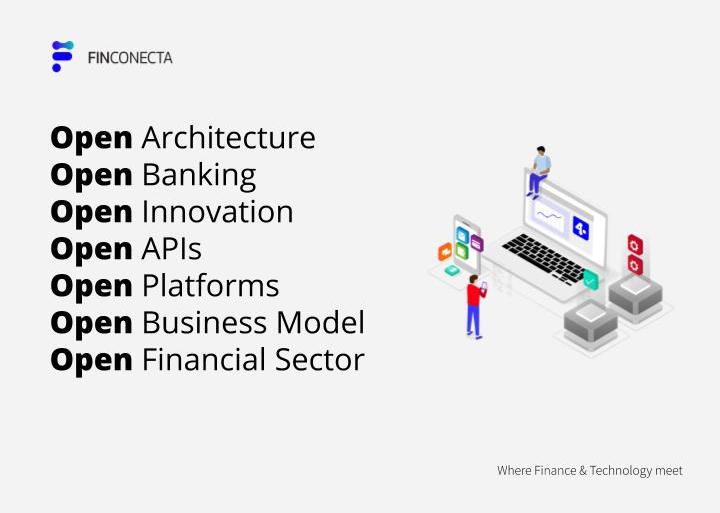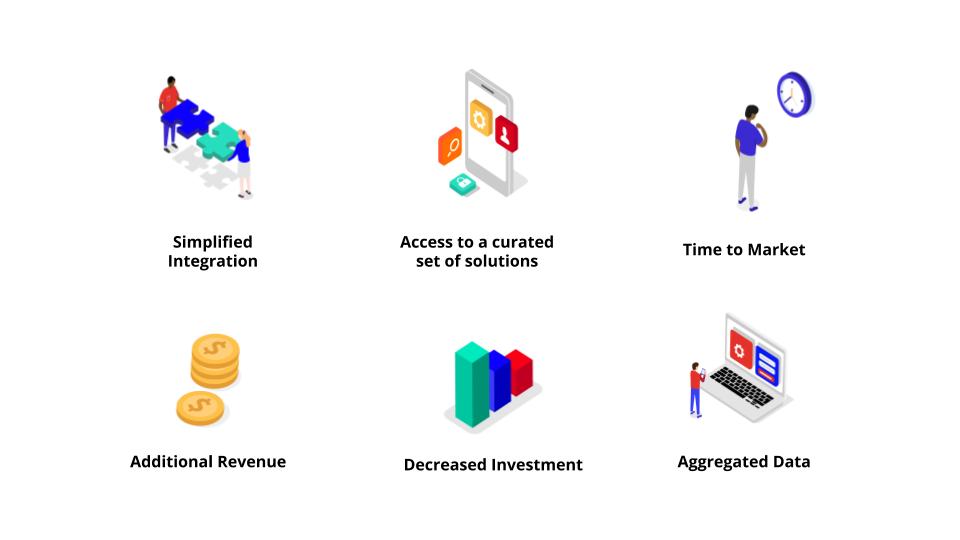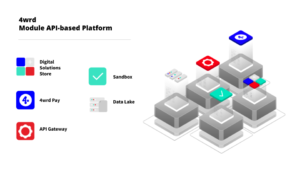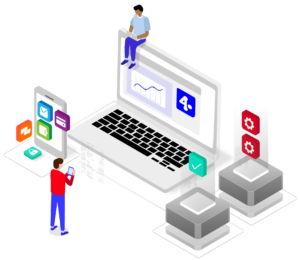
About Us
FinConecta is a technology company that brings together digital solutions and businesses in the financial world and beyond. With 300+ years of collective experience, FinConecta’s team is on a mission to drive digital acceleration worldwide, providing its clients with a holistic approach to sustainable transformation and a mindset shift in every step of the way.

FinConecta’s main objective is to build a global interconnected financial network that integrates key players in the financial services value chain; accelerating the digital transformation of the financial industry. 4wrd, FinConecta’s platform, is designed to incorporate all kinds of players in the financial sector (financial institutions, banks and others) with a marketplace of FinTechs from around the world, creating a financial ecosystem.
4wrd (forward), FinConecta’s open API cloud based platform, provides a secure and proven infrastructure to accelerate the adoption of cutting edge technologies. Partnering with financial institutions, 4wrd platform resolves interoperability constraints associated with legacy systems proposing a one-to-many efficient integration model, in contrast to the inefficient, traditional one-to-one model. The platform includes an API manager, cloud infrastructure, testing environment and a match-making marketplace of curated FinTechs.
FinConecta’s solutions help banks leapfrog to API-enabled business models and generate new revenues streams through collaboration. In 2017, FinConecta partnered with top development institutions like IDB- covering Latin America and FMO – covering the African region, to offer FinTech innovation programs designed to accelerate the digitalization of the financial industry and promote financial inclusion by exploiting existing innovative technologies.
In 2019, FinConecta in partnership with Prosa, the biggest payment processor in Mexico, launched FintSpace, the first marketplace at a country level. FintSpace by Prosa takes a central role as a driver and facilitator of innovation in the Mexican Financial Industry, positioning Prosa as a leader in Open Banking.
Through these programs and partnerships, FinConecta created the first global interconnected ecosystem which joins all relevant players of the financial industry. Our main focus lies in pairing and connecting Financial Institutions and Fintechs from all over the world. Today more than 20 institutions from Latin America, Africa, Asia, as well as hundreds of Fintechs from across the globe, are part of our ecosystem.
Our Platform 4wrd (forward)
4WRD is a platform conceived and developed to facilitate the integration of disparate systems in a secure, controlled and flexible manner. Designed for the digital age, 4WRD is the 4th generation of mission-critical enterprise service bus meant to provide institutions with a reliable and cost-effective platform for implementing service oriented solutions. The platform seamlessly integrates with any IT stack from financial and non-financial institutions, enabling access to third party solution providers around the world.
4wrd is built on the foundation of the most modern and reliable technological infrastructure of an open API gateway and an Enterprise Service Bus (ESB). The API gateway provides a safe docking mechanism for a digital application to consume and/or exchange services through a set of simple, standardized and regulatory compliant set of APIs. The financial institution service bus connects legacy systems with third party service providers, following an adequate integration methodology based on the financial institution technology architecture.
Offering a unique integration model, 4wrd opens the access to multiple technology solutions through one single integration, accelerating time to market at a fraction of the cost. This efficient integration capability, expand business models and create new revenue streams. Unlocking open banking and open innovation, 4wrd supports financial institutions on their digital transformation journey.
Main Benefits of 4wrd

- Simplified Integration. Integration of systems is a complex and labor intense activity. It is also extremely sensitive to changes. Establishing a relation between multiple applications in a point-to-point manner multiplies that complexity. By creating a common interface to be adopted by 3rd party developers and institutions and a common set of practices and rules that govern the collaboration process across multiple parties, 4wrd contributes to simplify integration processes in 10 times.
- Access to a curated set of solutions. Identifying the right FinTech partners with whom to engage can be a complicated endeavor for Financial Institutions (FIs). There are solutions for each of the financial services, but not all of them suits FIs’ needs. Even if the technology is a good match, there is the need to align business goals. The digital solutions store of 4wrd features an online catalog of a premium array of 100+ curated solutions.
- Time to market. Based on personalization, quick response, relevance, seamless delivery and lower rates, new players in the financial industry are gaining traction. It is imperative for banks to partner with FinTech companies to stay ahead of technological evolution. At FinConecta we believe that standardization of services and normalization of data is a fundamental part of enabling institutions to collaborate with external solutions developers in the most time and cost effective manner.
- Additional revenues. When suppliers, partners and developers start building together, they create value and accelerate growth for all involved. API marketplaces where developers can access a banks’ APIs catalog, use them, provide feedback, and request new features are emerging in the financial industry. Embracing platform business models, banks are achieving improvements in profitability, innovation and access to new markets.
- Decreased Investment. Adopting the Open Banking model, banks are delivering cutting-edge products without a significant investment in developing innovation. By reducing development costs and infrastructure overhead, open APIs provide notable savings. In addition, as the integration of cloud computing increases, many software providers are adding Software-as-a-Service capabilities that eliminate the upfront cost of purchase/license, as well as maintenance and upgrades. Pay-as-you-go models allow banks to rent the software instead of purchasing it, which translates in moving from capital expenditure to operating expenditure.
- Aggregated data. By building an integrated and interconnected holistic solution, banks not only expand their offering beyond a limited portfolio, they can also capture data that will provide a complete view of customer’s needs fostering customer loyalty in the long term. On top of enabling high-quality digital experiences, the marketplace model strategy empowers financial institutions to add new revenue streams through cross-selling and up-selling with data analytics.
4wrd Blueprint
4wrd is a universal, modular, non-intrusive and stateless integrator engine. It was created with an open architecture vision implementing components that are considered best-in-class in their domains. The main objective is to provide a secure, scalable, business agnostic, and industry compliant infrastructure ready for delivering state of the digital art solutions.
The platform is composed by three sets of modules that are loosely assembled for maximum delivery and operational ability. These groups of features are shown in the diagram below and described next.
- Foundation Components. Provide optimum scalability and performance. While it is currently using WSO2 and AWS features, the platform is portable and will likely be implemented in a multitude of cloud and API frameworks in the near future. The objective is to ensure minimal latency as institutions adopt the platform around the world.
- Extended Capabilities. These are products that provide specific features that allow services to be managed independently from the entities currently offering them. In other words, those are the components that will allow replacement of digital solution providers with minimal or no impact to clients and businesses.
- FinConecta Components. Where the core of the orchestration process resides. This is where the combined experience of our team building reliable mission-critical switch solutions for more than two decades came to life.

Open Banking
Implementing and exposing APIs is not sufficient to ensure collaboration among parties. The financial institution has to provide a high level of service, support, security, and continuous improvement to engage developers and encourage them to connect. API consumers expect secure transmission and consumption of data. To manage risk and ensure compliance, the infrastructure should be robust.
Open Banking Live by FinConecta is a turnkey solution that allows Financial Institutions to comply with local regulations around Open Banking as well as benefiting from and monetizing this effort. This solution provide banks with the infrastructure for the transition to open banking, developing standardized APIs to allow easy integration to third party providers.
Open Banking Live includes key elements needed for Open Banking Initiatives:
- Developer Portal, aiming to drive awareness, enable exploration and simplify onboarding. It makes clear to developers what are the business opportunities being offered by the API provider.
- Consent management module, to meet regulatory requirements about data privacy. Banks must enable customer and third party provider identity verification and authentication to control access.
- API consumer registration, to perform due-diligence analysis and vetting over developers. Banks should establish criteria for accepting or rejecting FinTech partners.
- API manager to control API accesses and manage multiple relationships. The API Provider should be able to track requests, audit use and charge third parties for use.
- Sandbox environment, to allow testing before going into production. Experimentation is key, so the developer portal includes reading documentation, reference guides along a secure environment to make test API calls.
- Safety protocols, to protect products from threats. Establish an incident management policy to address data breach or fraudulent activity. Protect the system against capacity overload to legitimate peaks in data requests from verified third party providers.
- Monitoring, to detect and address service disruptions. Remediate issues before they impact the ecosystem.24/7 claims and support.
- Analytics and performance trackers, to monitor revenue rates and measure operational metrics. Understand APIs that are critical to customers based on high volume usage, identify early trends in product usage to hence/revamp services.
Integration Approaches
There are five different alternatives to establish the interface between 4WRD platform and the institution’s core system:
- Using the institution’s API portal if available;
- Connecting to existing web services previously developed in support to institution’s distribution channels (i.e. internet banking, call centers, ATMs, etc);
- Direct connection to core product processors using traditional protocols such as ISO, fixed format, TCP/IP, SNA, etc.
- HTTPS scrapping of an intranet application where financial services are available (i.e. call center or teller working interface);
- Direct connection to the core processor database using JDBC interface;
Methodology
FinConecta assemblies a multidisciplinary team that works with a mix of methodologies (Scrum, DevOps, Design Thinking and Design Sprint) oriented to business results. In contrast to a waterfall framework, the lean and agile approach allow teams to deliver incremental capabilities to projects in a very short time frame. This allows businesses to adjust their roadmap according to features that are valuable for the customer instead of building up significant amount of functionalities that will eventually be obsolete.
Backlog
Suggested changes and/or comments are documented and reviewed in a single repository for capturing (backlog) all the activities that need to be executed by the team. It must include all elements that are envisioned for the product and service being launched regardless of when it is expected to be fulfilled. The backlog is dynamic and should not be limited in any aspect. It is the place where all ideas, new request, and product defects are stored for further review and prioritization
Recurrent Sessions
All stakeholders meet periodically according to the scope and objective of the agenda defined for each session. The meetings can be organized according to the needs of the interested parties; however, the following sessions will be recurrent:
- Scrum Sessions. These will take place every 15 days and will follow up on progress reports and information on deliverables. All parties that were given a specific task or that have recently ended an assignment must attend.
- Management Sessions. These will be executed at the end of each report. Senior executives or those responsible for the decision making must attend (Steering Committee).
Sprints
Sprints are a predefined cycle of activities agreed by all members of the project team. They are often structured in 1 or 2-week intervals where a group of tasks are pulled from the backlog to be executed. Once a week the team holds a meeting to evaluate its progress, assess the challenges, review the backlog, and prioritize the activities for the next sprint. At this time, each person reviews the backlog, identify the tasks they are either meant to execute or are capable of executing, and assign them both a number of points and a due date (when they expect it to be completed), which should be before the sprint ends.
Available Tools
The teams can take advantage of a wide array of support applications such as: Slack, Zoom, dedicated Google Drive , Workast as backlog manager.

READY to move 4wrd (forward)? Contact us at contact@finconecta.com
